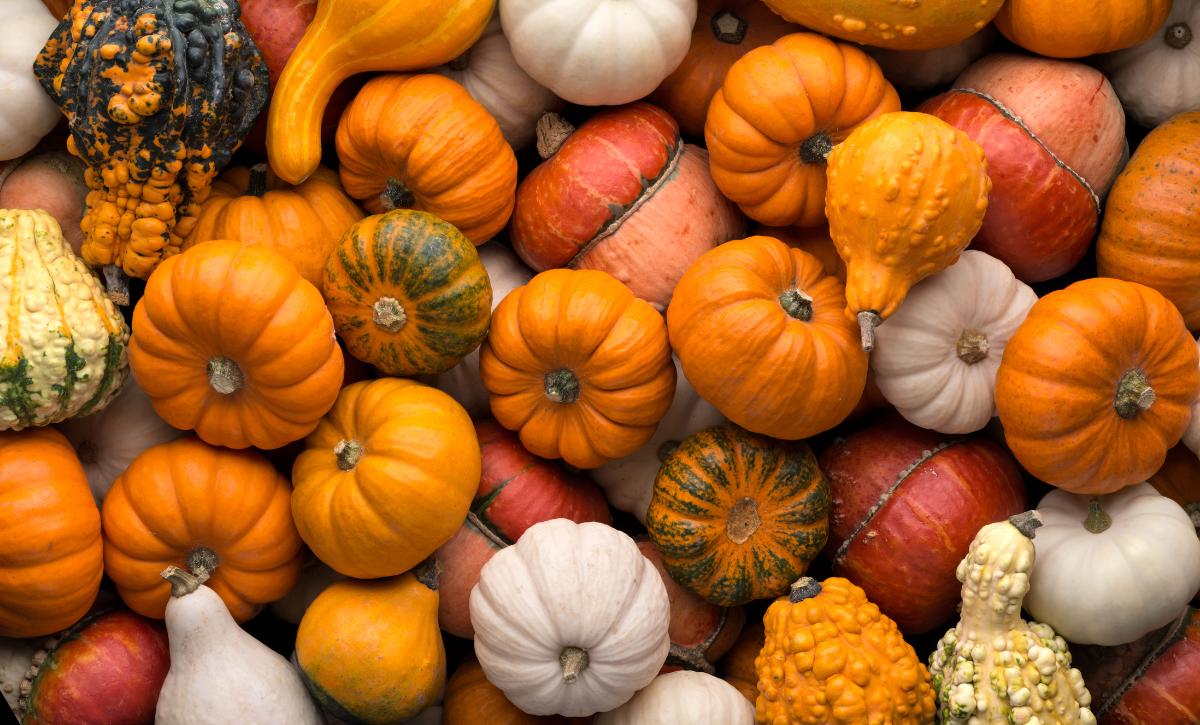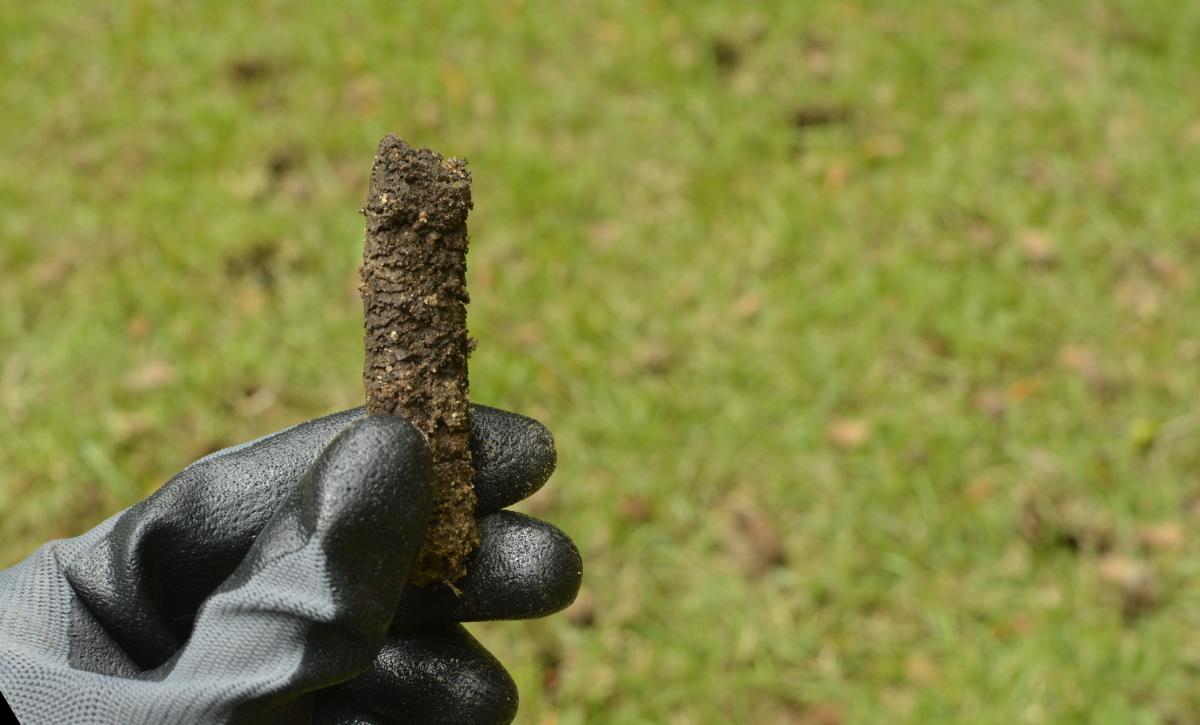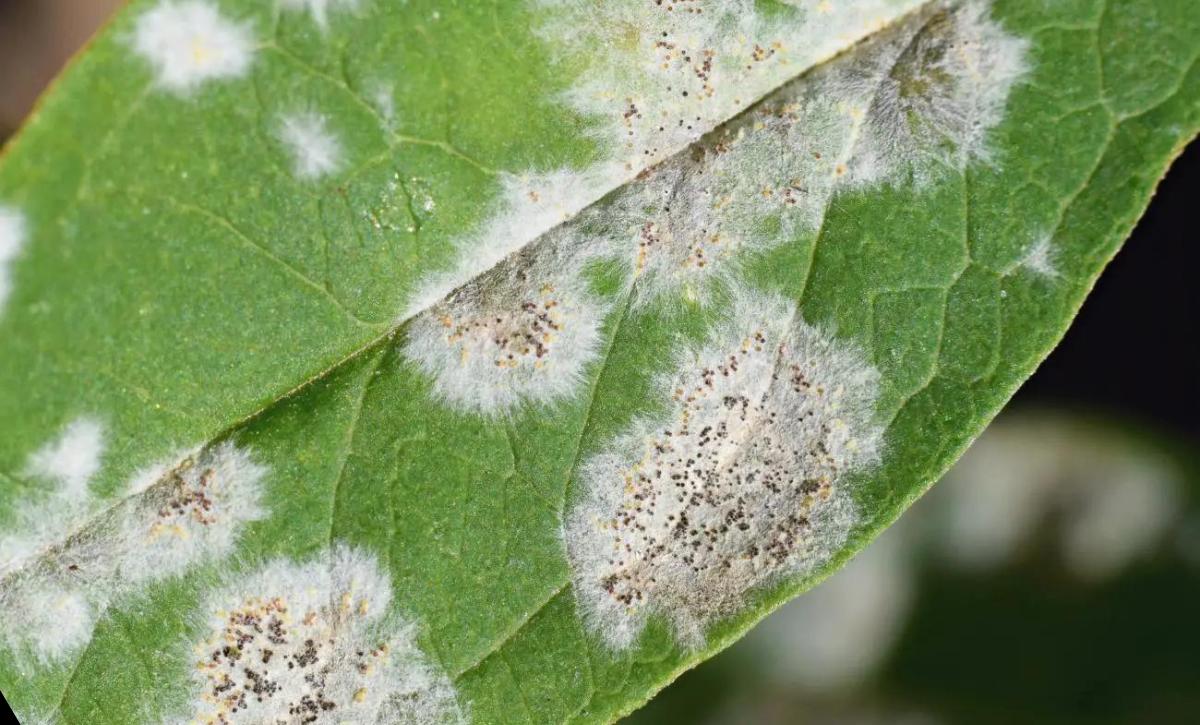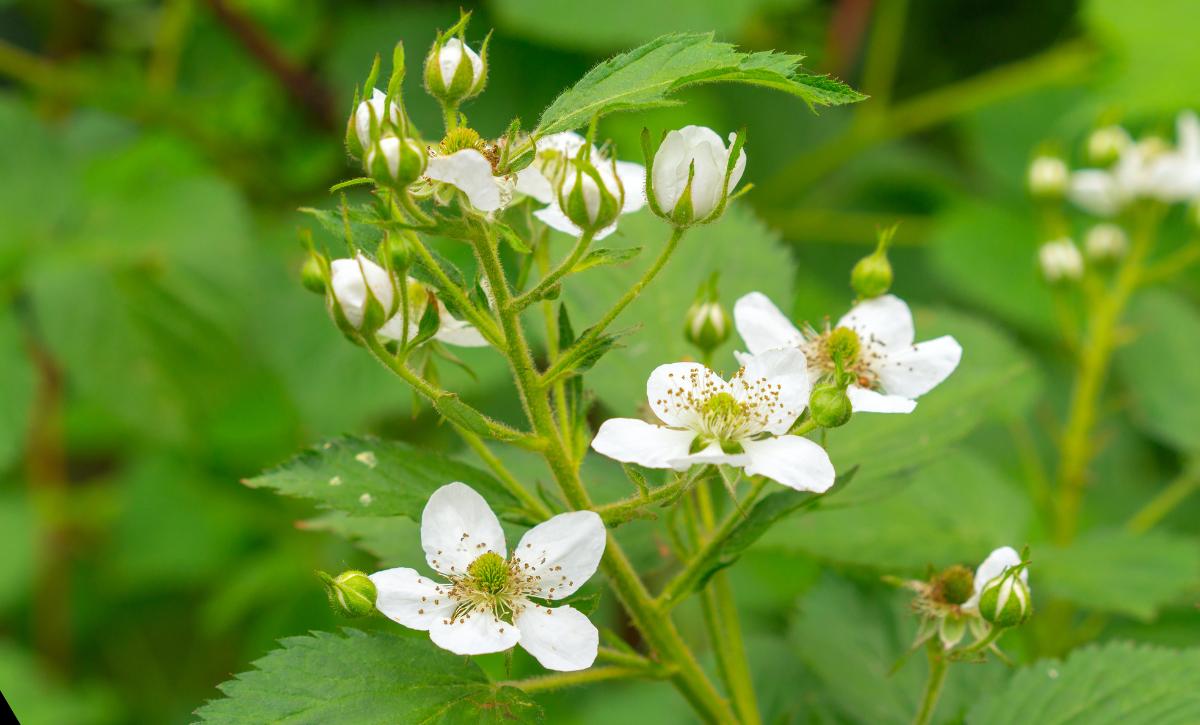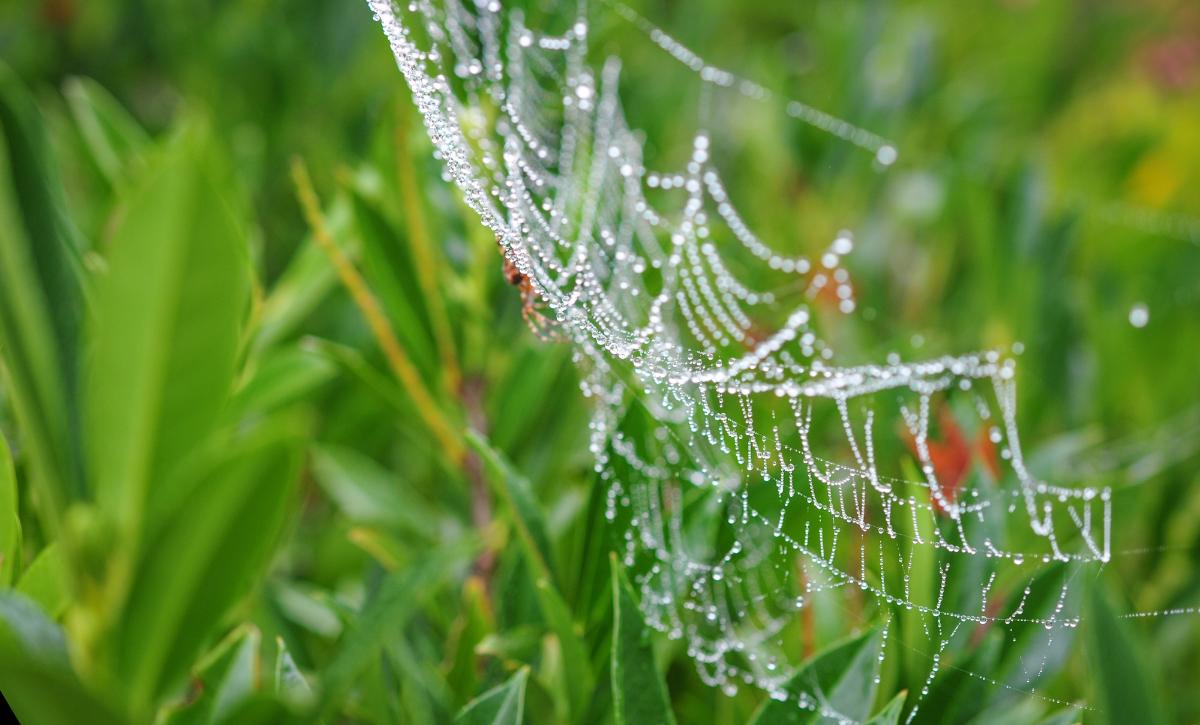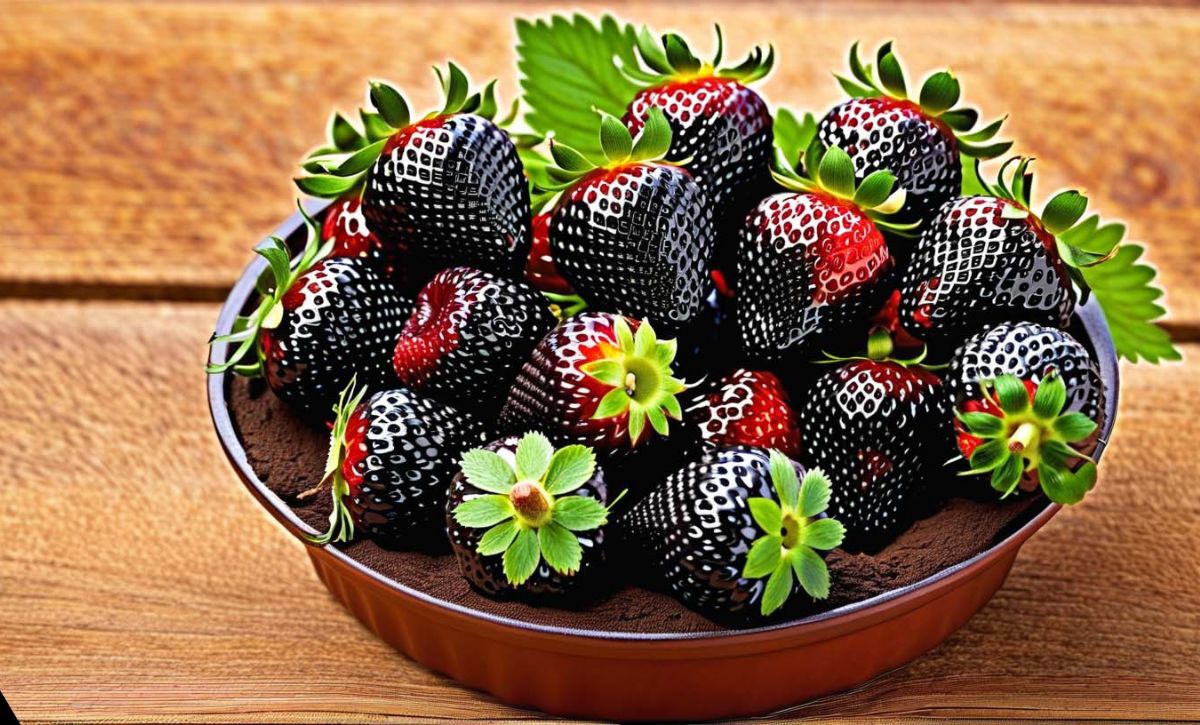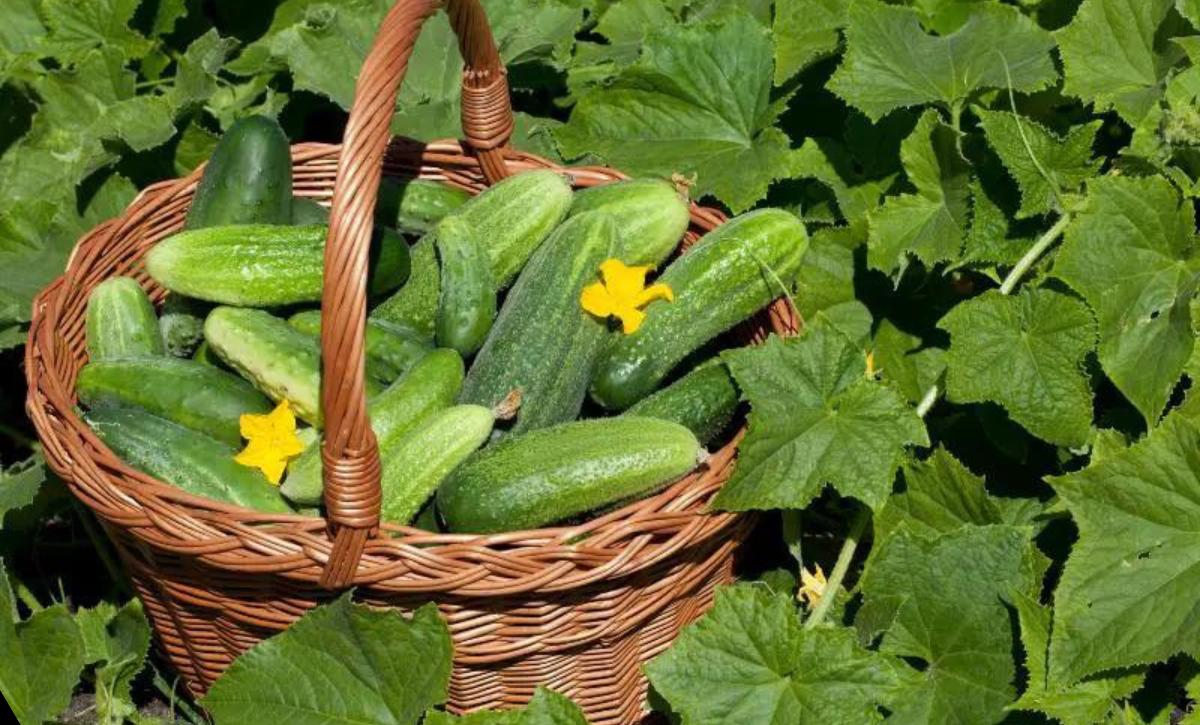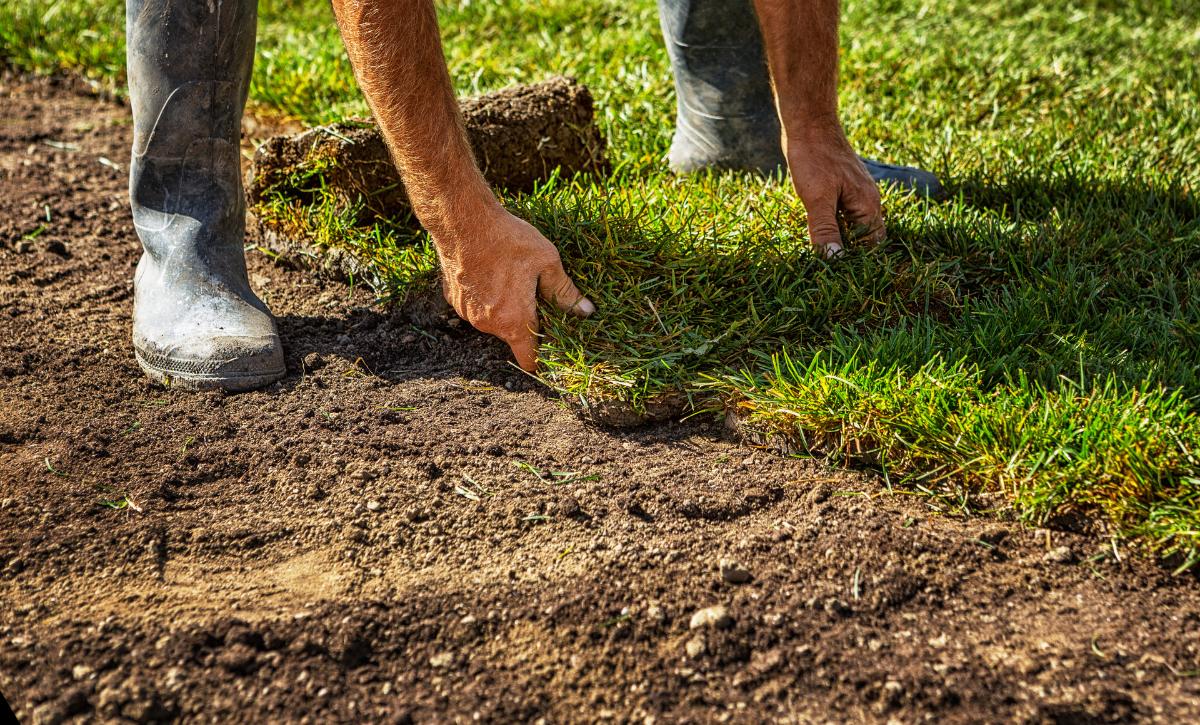There are so many things you can decorate beautifully using small yellow flowers, including borders, rock gardens, and flower beds. Unfortunately, they don’t have the same magical effect on lawns.
Sometimes, you might see some black-eyed Susans or dandelions growing all over your grass, and the first thing that comes to your mind is to eliminate them and restore your lawn to its former glory.
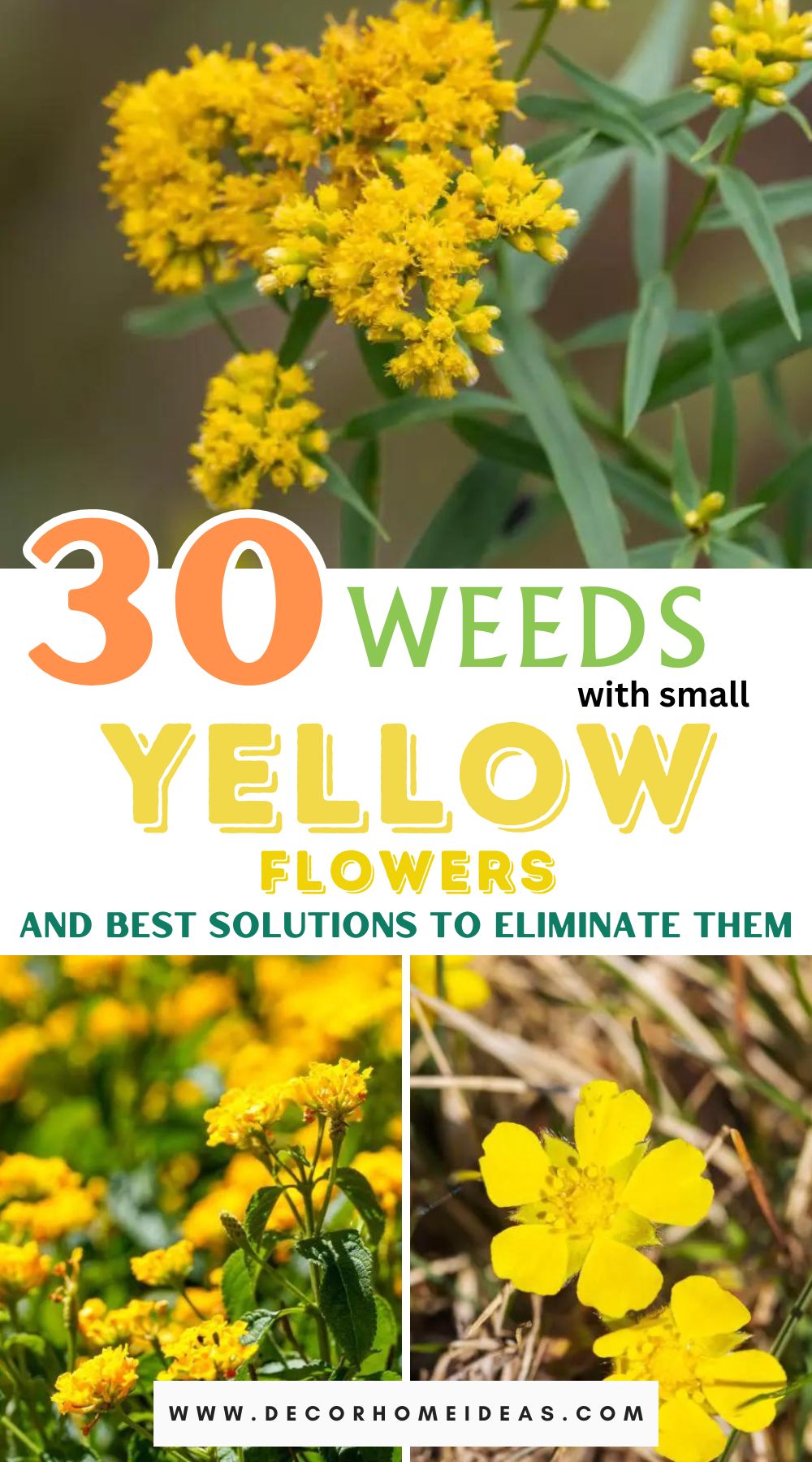
Today, we’re going to examine some common weeds that have tiny yellow flowers, show what they can do to your yard, and provide some helpful tips for getting rid of them.
Let’s get into it!
Canada Goldenrod
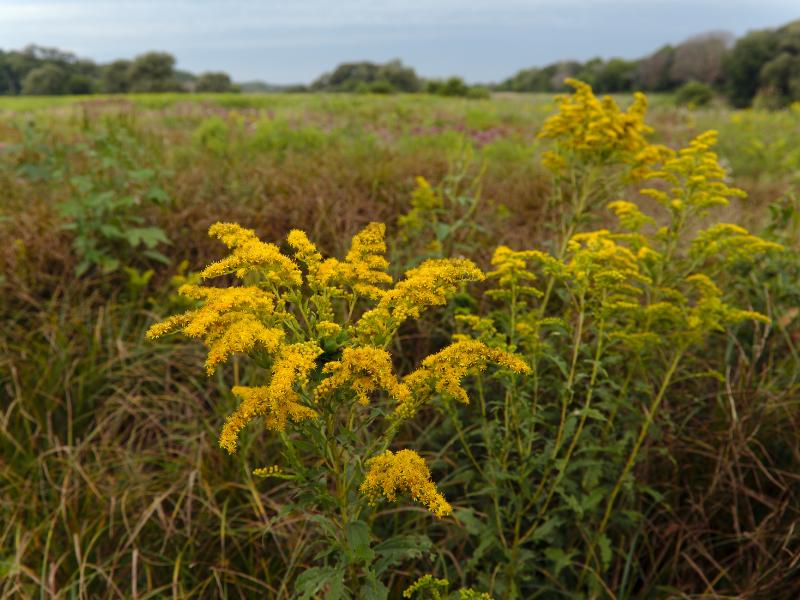
Identification: If you happen to meet the Canada goldenrod, you’ll notice that its flowers don’t look like real flowers at all. Rather, they resemble pyramidal stems covered in millions of hairy blossoms. The plant’s leaves are deep green, toothed, and lanceolate and narrow towards the base. Although the plant can reach heights up to 6 feet, it typically stops growing once it reaches 2 – 4 feet.
Effect: The Canada goldenrod has light seeds that are easily transferred by the wind, and they can quickly germinate. The weed competes with your grasses and other floral cultivars, suffocating and overcrowding them. Its size will also easily taint your lawn!
Restraint: Use weed killers with triclopyr to completely eliminate any young Canada goldenrod you notice on your grass. However, it’s good to note that this herbicide can cause damage to regular grass species in Florida or other warm places, so overseed after applying it.
Butterweed
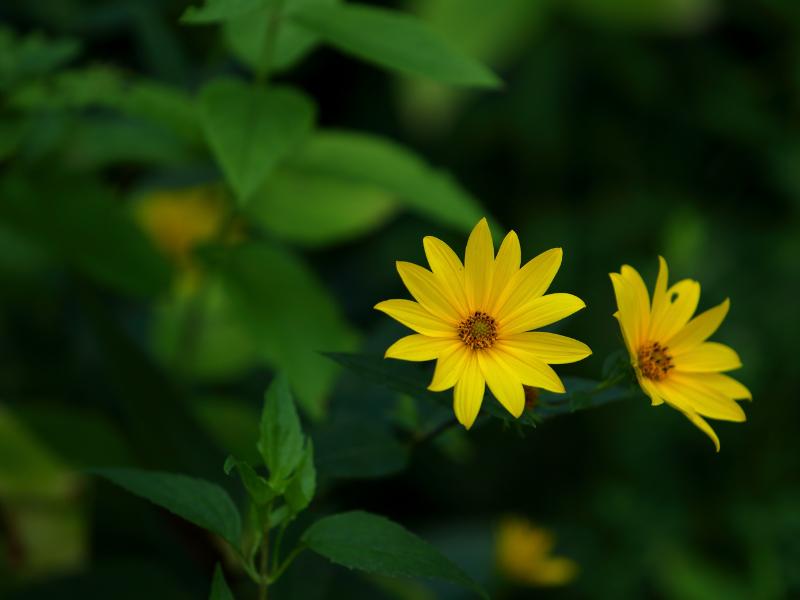
Identification: Honestly, the buttery yellow petals on the butterweed and their deeper orange or yellow discs are quite good-looking. The plant’s leaves have smooth edges while it’s still young, but the foliage becomes more lobed as it matures. It can reach a height of around 3 feet and is severely toxic to cattle and horses, so its ingestion can be fatal.
Effect: The butterweed is native to North America, but it can also spread aggressively and overcome other plants. The plant is also toxic to humans and can cause digestive problems for your pets, so eliminating it from your lawn is the best option.
Restraint: 2,4-D is the best way to control this plant while the weed is in the flowering phase, even though you need to apply it more than once.
Black Medic
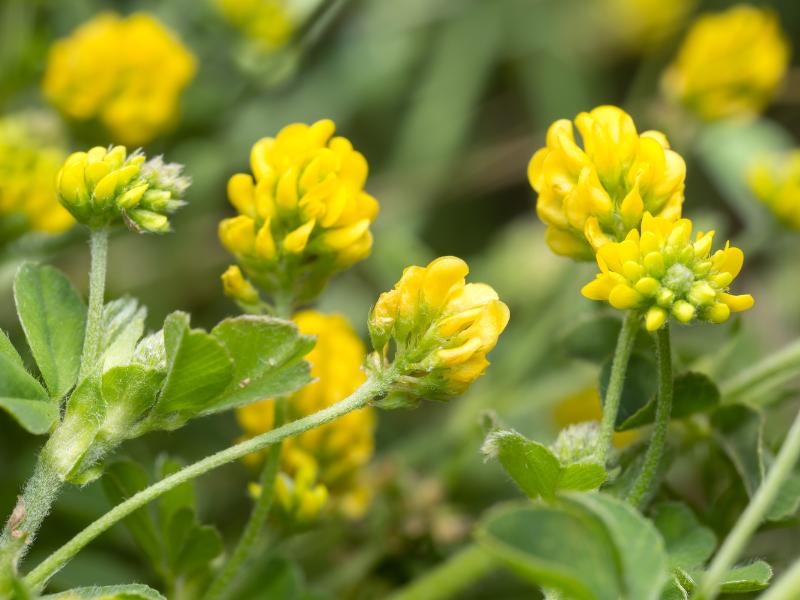
Identification: The black medic belongs to the legume family and has trifoliate oval foliage and globe-shaped flower heads, and it holds a close resemblance to clover. It’s usually a short-lived or annual perennial and grows 1 – 2 feet tall.
Effect: This plant grows stronger than lawn grass as a result of its deep taproot. It can also prevent grass seeds’ germination and lead to ugly-looking patches since it’s low-growing. The black medic weed grows aggressively and is non-native.
Restraint: As mentioned earlier, the black medic have deep taproots, so they’re challenging to pull out. As such, use post-emergent herbicides containing fluroxypyr, MCPP, and dicamba to suppress their growth. Prevention is better than cure, so keep your lawn fertilized and well-watered and mow it regularly, and you won’t have to worry about the black medic as such.
Black-Eyed Susan
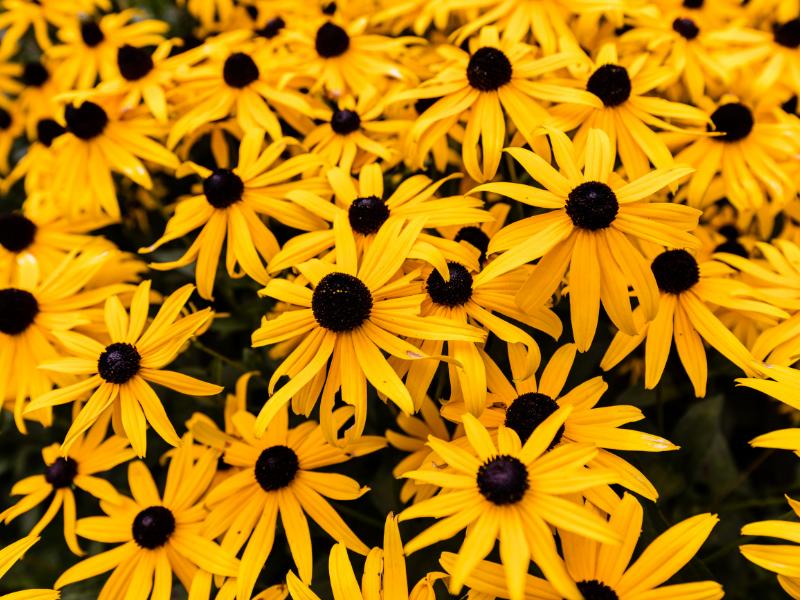
Identification: Black-eyed Susan is a smaller version of the sunflower, and it actually looks great when grown in flower beds. It’s usually 1 – 3 feet tall, even though some types can reach heights of up to 4 – 6 feet! The plant produces yellow flowers with black disks at the center, which are surrounded by narrow, ovate or lanceolate leaves.
Effect: Even though the black-eyed susan isn’t regarded as an invasive species, it grows aggressively and can easily take over your yard. Also, it’ll get tall and disrupt all the work you’ve put into your beautiful lawn.
Restraint: Remove the flower heads before they produce seeds to control the spread of this plant naturally. This way, they won’t be able to propagate. Also, remove the whole plant together with all the rhizomes since even the most minor bits can produce new plants.
Bird’s Foot Trefoil
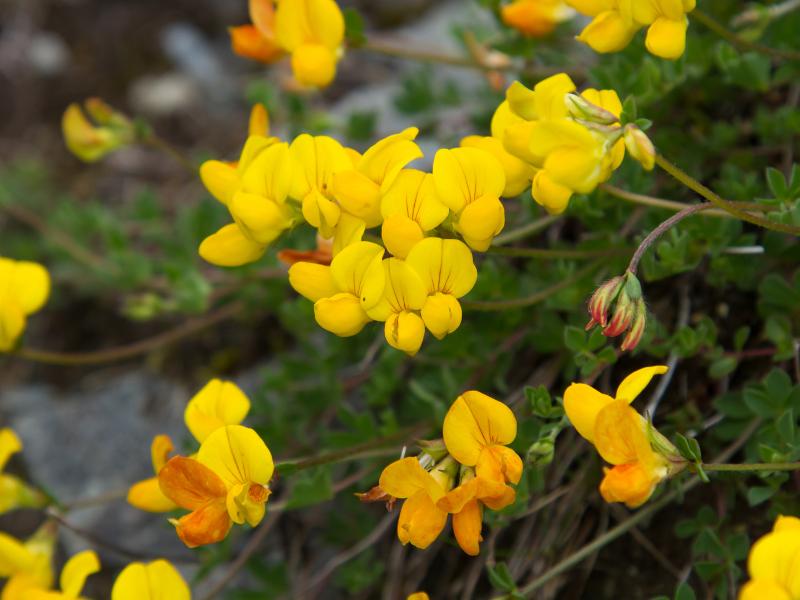
Identification: Tiny yellow flowers of this plant can adorn various places, but they don’t look great on lawns at all. The bird’s foot trefoil has oblanceolate leaves that possess smooth edges, and the whole low-growing plant reaches a height of 1 – 2 feet.
Effect: The plant spreads by stolons and rhizomes and can self-seed. The bird’s foot trefoil can choke out grass and other plants and is invasive in many parts of North America, which is why you should eliminate it from your lawn.
Restraint: The bird’s foot trefoil flourishes in infertile and drought-prone soils, so caring for your lawn correctly in terms of irrigation, fertilization, and mowing can prevent it. Additionally, your grass will be able to grow aggressively and hinder the weeds from growing. If this doesn’t solve your problem, you can apply some weed killers containing 2,4-D, MCPP, and dicamba to get rid of it.
Common St. John’s-Wort
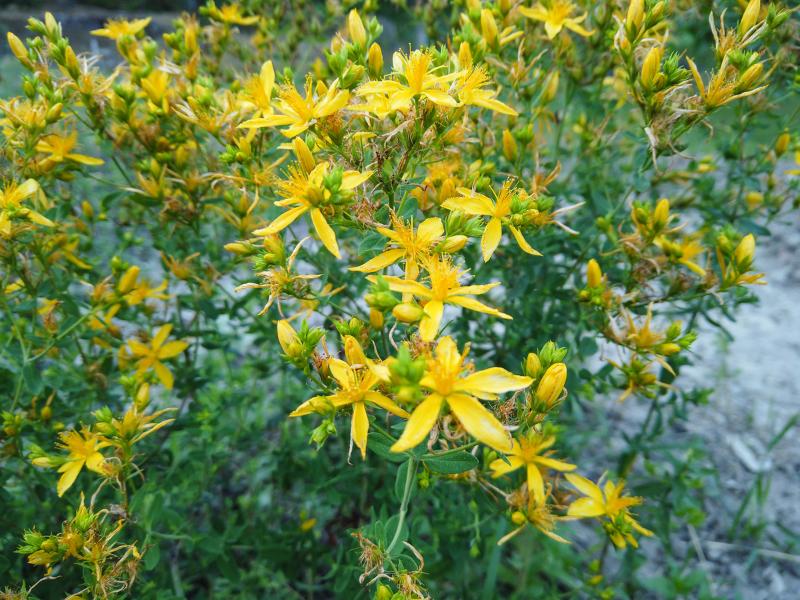
Identification: The flowers of St. John’s-wort resemble real yellow stars, especially when you realize its myriad stamens look like light rays. Smooth, narrow, and oblong leaves adorn the whole plant. It has a width of 3 – 6 feet and can reach a height of 6 feet.
Effect: This cultivar spreads by seeds and rhizomes, producing up to 34,000 seeds yearly. As such, it’s able to invade a large section of land and harm many animals, causing dead tissue, skin lesions, and other health-related issues.
Restraint: Maintaining a healthy lawn is the best way to prevent this weed’s growth because competition hinders the growth of St. John’s-wort seedlings. You can achieve this by mowing, watering, and fertilizing your grasses regularly. You can also pull the plants out if there are only a couple of them. Otherwise, use herbicides with metsulfuron or 2,4-D.
Common Ragwort
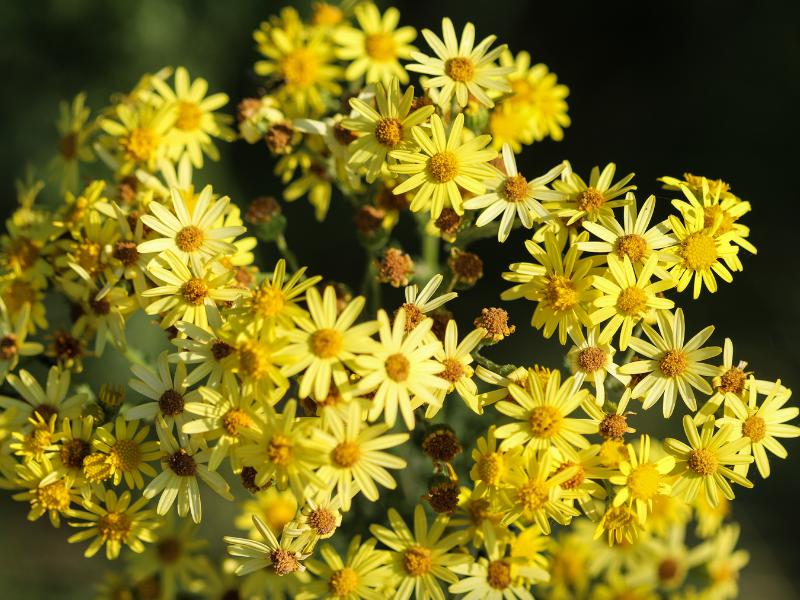
Identification: Ragwort is a member of the daisy family. That’s why it has an attractive look. The plant has short stems supporting pinnate, lobed leaves, and numerous yellow flowers. The common ragwort is also called stinking willie, so that should probably give you a good idea why most people want to eliminate it. The plant can reach heights of at least 18 – 30 inches.
Effect: The common ragwort is poisonous and can harm pigs, chickens, horses, cattle, etc. The plant can spread rapidly all over your yard because it produces thousands of seeds in 4 – 6 weeks. It can quickly become invasive, so it would be best to do away with it as quickly as you can.
Restraint: Mow the weed before it flowers to stop it from seeding and prevent it from spreading all over your lawn. If the plant is localized to one area, you can pull it from the ground, but you’ll have to take the whole root system out. Plowing is another excellent alternative, but you can always use herbicides with 2,4-D or MCPP if plowing isn’t an option for you.
Common Evening Primrose
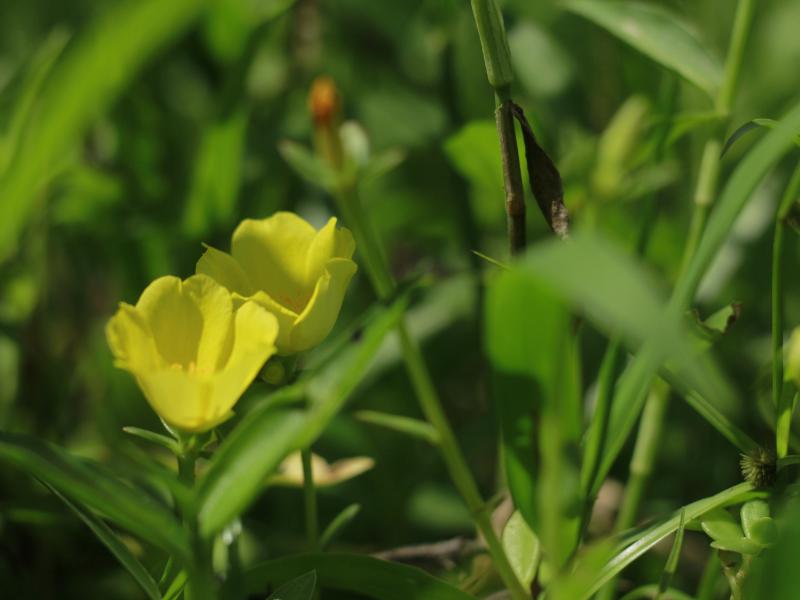
Identification: The common evening primrose has lemon yellow, bell-shaped flowers, which have an exciting cycle. Its flowers are open from evening until morning and close once the heat re-emerges. The plant can grow up to 2 – 6 feet tall and has numerous lanceolate, narrow leaves all along the stem.
Effect: This primrose isn’t the typical day-to-day weed, but it still self-seeds and spreads like one. Mowing won’t help much when dealing with this weed since it can also multiply by rhizomes. The plant’s size will disrupt your beautiful lawn appearance, so either completely eliminate it or move it to a flower bed.
Restraint: The best way to get rid of the common evening primrose is to mow it before it flowers since it prevents it from self-seeding, and then pull it out of the ground. Ensure you remove the whole root system to prevent it from growing again. If the weed has covered large tracts of land, you can use some broadleaf herbicides to treat it.
Creeping Cinquefoil
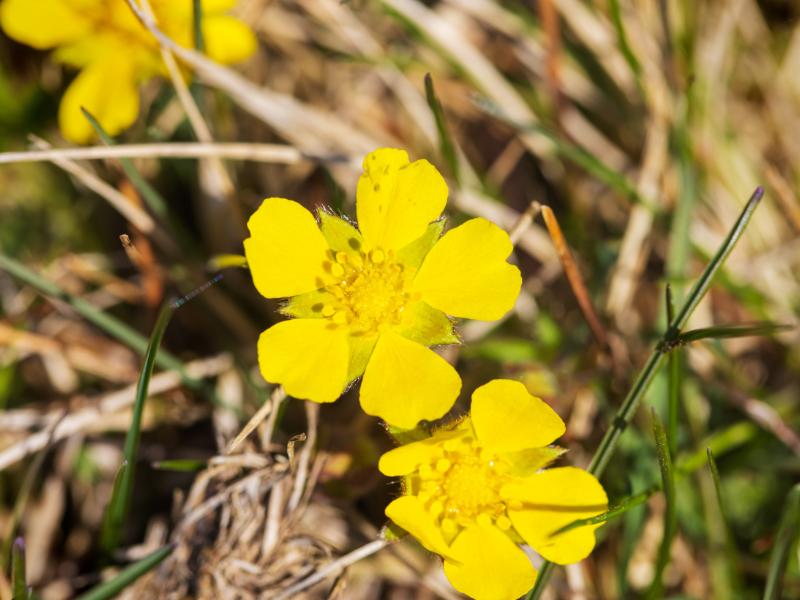
Identification: The creeping cinquefoil has yellow heart-shaped petals that form its cup, and, to tell you the truth, they don’t look that bad at all! Nonetheless, its toothed and oblong, deep green leaves don’t really do well with lawns, so it’s always best to remove it when it emerges on your lawn. Fortunately, your grass can overcrowd it since it doesn’t grow taller than 6 inches, so there’s no need to worry even if you forget to get rid of it.
Effect: The creeping cinquefoil spreads runners, which root quickly and can invade your whole yard within no time. The plant is considered invasive and, given the chance, will suffocate the rest of your plants.
Restraint: To deter the development of creeping cinquefoil, ensure there are perfect conditions for grass growth through proper lawn care. This involves regular irrigation, mowing, fertilization, and aeration. Pulling this plant entirely out of the ground might be challenging since it has deep roots, but you can use herbicides containing dicamba, 2,4-D, etc.
Creeping Buttercup
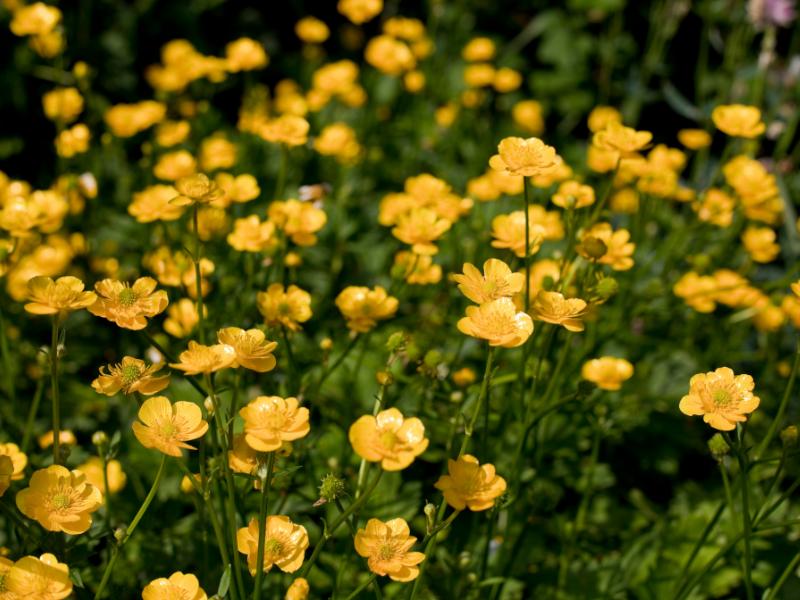
Identification: The triangular or egg-like serrated leaves and the bright yellow cup-shaped flowers make it challenging to eliminate this weed from your lawn. The creeping buttercup reaches heights of 1.5 feet, but you can still see it among the blades of grass.
Effect: This plant is known for competing with lawns for nutrients, particularly potassium, and spreads by stolons and seeds. Therefore, you shouldn’t allow it to run rampant since it’ll tarnish your beautiful green lawn and put it at risk.
Restraint: Post-emergent weed killers with aminopyralid, MCPA, and 2,4-D are best for dealing with this type of weed.
Cypress Spurge
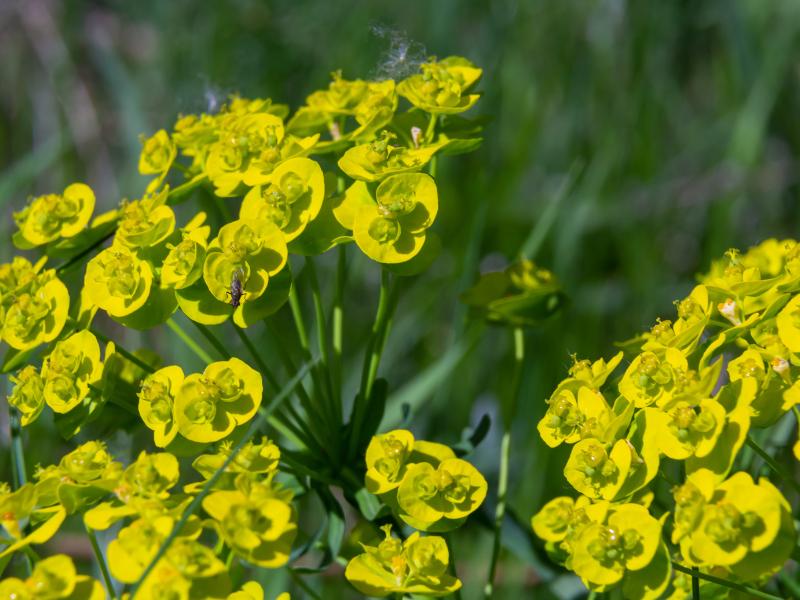
Identification: The cypress spurge can grow up to 6 – 12 inches in height and appear as a bushy ground cover. The plant has bright yellow cup-shaped flowers and linear light green leaves that aren’t that pleasant-looking, so you’ll have no guilt when you eradicate this weed.
Effect: The cypress spurge typically spreads by seeds, but it can multiply by rhizomes too. The weed contains latex, which can cause blindness and skin irritations, so it isn’t safe for humans and animals. The plant is an aggressive grower and will suffocate your native grasses and plants.
Restraint: Regular lawn care is an excellent way to deter the growth of cypress spurge since it flourishes in poor and dry soils. Pulling or digging it out is also another option, but ensure you remove every rhizome because it can grow from the root remnants. After you pull out the weed, apply a weed killer with picloram, 2,4-D and dicamba, or quinclorac to kill it completely.
Dandelion
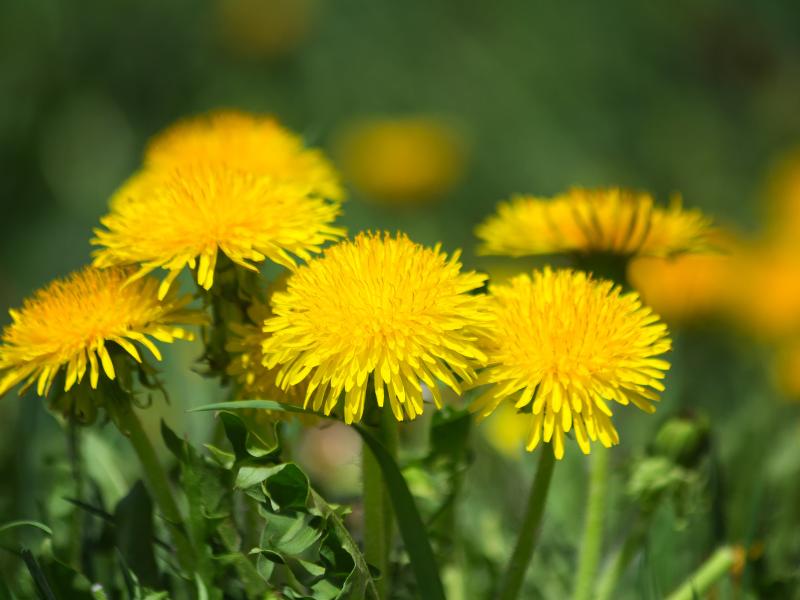
Identification: Dandelions have lovely yellow flower heads and airy circles that beautify your lawn, so eradicating them isn’t really necessary. The plant grows to heights of 2 – 24 inches, so it’ll hardly ruin your grass; furthermore, you can harvest its spear-shaped serrated leaves and use them in your salads.
Effect: These plants spread by roots or seeds and can quickly invade your whole lawn. Dandelions grow in short clumps and present an unsightly display if you are keen on having a neat lawn.
Restraint: Luckily, there are some excellent herbicides for bermuda grass that won’t damage your lawn but will eradicate this broadleaf weed. It would be best to use a herbicide with compounds like fluroxypyr, 2,4-D, dicamba, etc.
Golden Clover
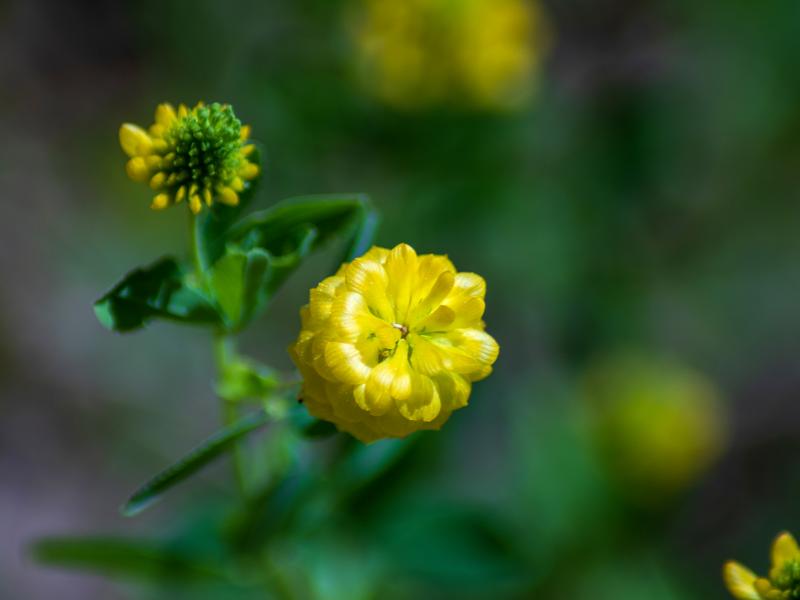
Identification: This plant is also called the large hop clover (or hop clover). The golden clover has smooth, elliptic, oblong, or rhombic foliage and a single oval or round flower. The plant typically reaches heights of 2 – 8 inches tall, so there’s a high probability it’ll be overcrowded by your lawn grass without you even noticing.
Effect: Even though this weed can attract pollinators, it spreads fast. It can rapidly increase its numbers since it’s non-native, and you’ll see small yellow heads sprouting in your entire lawn. Furthermore, the Invasive Plant Atlas of the U.S. considers this species as invasive.
Restraint: The golden clover is an annual, and maintaining healthy, dense, and vigorous grass is your best chance of inhibiting this weed from taking over your entire yard. Pulling it out is also an option if there are only a few plants on your lawn. If you want another alternative, weed killers containing triclopyr or glyphosate are also effective. However, it would be best to care for your lawn and weed it rather than use herbicides, especially when dealing with home landscapes.
Garden Loosestrife
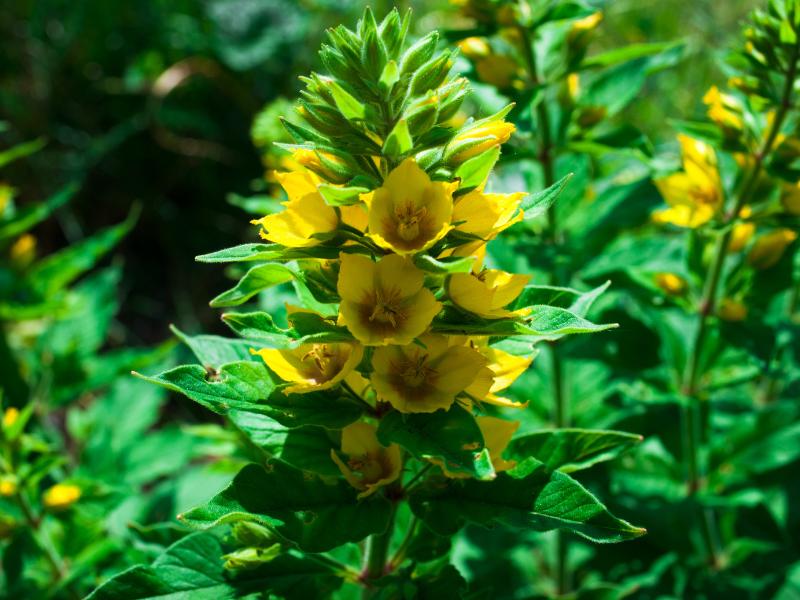
Identification: The garden loosestrife has a pyramidal flower head that has numerous bright or golden yellow cup-shaped flowers. The most distinguishing feature of this plant is its egg-shaped or sometimes lanceolate leaves, which mostly come in threes. It has an overall bushy appearance and typically gets 2 – 3 feet tall.
Effect: The garden loosestrife spreads from rhizomes and seeds, even though the former is more critical. The plants expand deep into the ground, making it challenging to remove them; it always seems like they are coming back stronger than before! The plant is considered invasive and could overcome your other plants.
Restraint: Digging and pulling out these weeds are excellent options if there aren’t many of them on your lawn. The plant can sprout from the tiniest of root fragments, so ensure you remove the entire rhizome. Use herbicides with compounds like imazapyr, triclopyr, and glyphosate.
Grass-Leaved Goldenrod
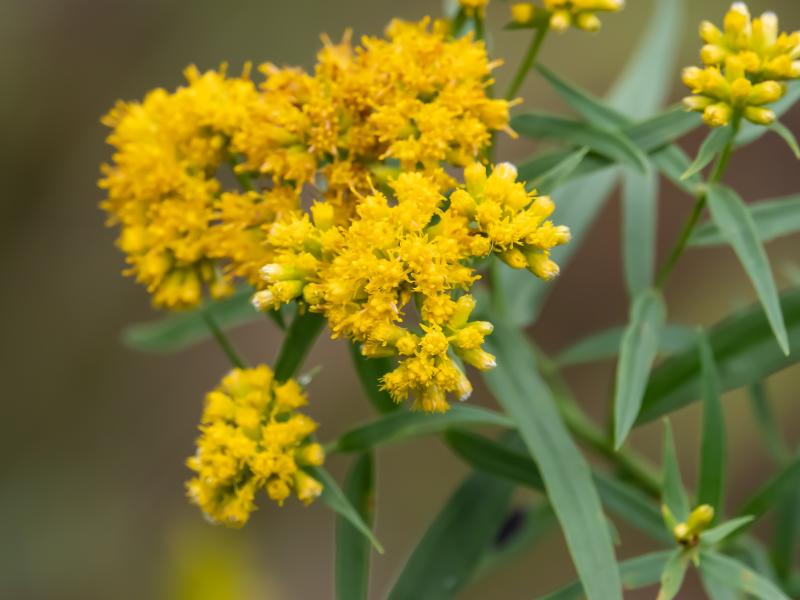
Identification: The grass-leaved goldenrod has a disk-shaped flower head that contains numerous cylindrical flowers. Just like its name, its foliage resembles grass, even though its stem would pop out of your lawn even if there aren’t any golden blossoms. The plants can reach a height of 2 – 3.5 feet and can be bushy or narrow.
Effect: This plant primarily spreads through rhizomes, but the aggressive nature by which it does this makes it capable of taking over your garden in no time, especially when it gets a lot of sunlight. The root system and leaves of the plant also exude compounds that deter the growth of surrounding plants, so its spread will slowly deteriorate your lawn.
Restraint: Applying herbicides and proper lawn care are the best ways to eliminate this weed. Use products containing 2,4-D, dicamba, and triclopyr, and ensure you carefully follow the manufacturer’s instructions on the package.
Lesser Celandine
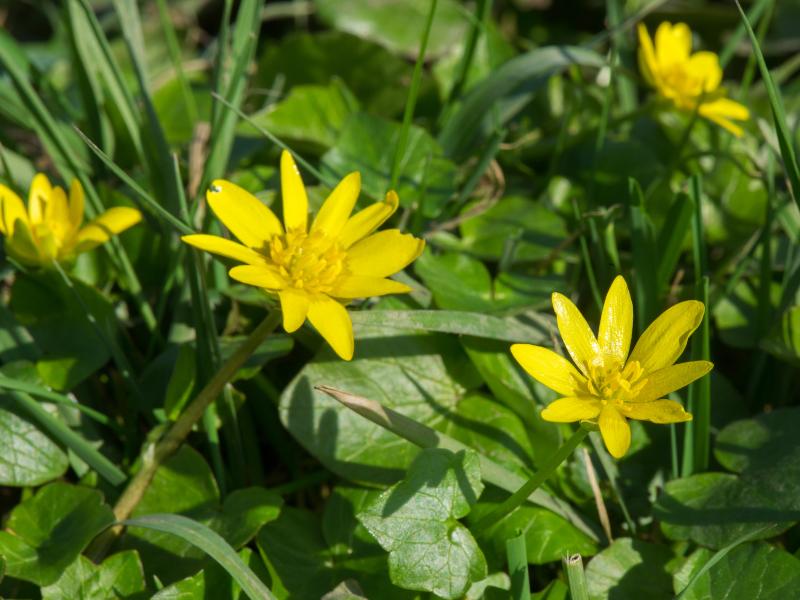
Identification: The lesser celandine has lotus-like leaves and star-shaped yellow flowers that won’t necessarily taint your lawn’s appearance. Also, the plant typically grows about a foot tall, so it won’t stick out of your lawn as much.
Effect: This plant flourishes in nutrient-rich mediums and can tolerate shade. This makes it very challenging to eliminate it since maintaining a healthy lawn promotes its growth! It’s invasive, grows vigorously, and will outcompete other plants around it. It spreads by bulblets and tubers, disturbing the soil, or through seeds.
Restraint: Weeding this plant won’t be that effective since it spreads through seeds and tubers as well, unless you have the willingness and patience to sift through the soil while removing even the smallest root remnants. Rather, consider herbicides containing glyphosate and triclopyr to eradicate your problem completely.
Marsh Yellowcress
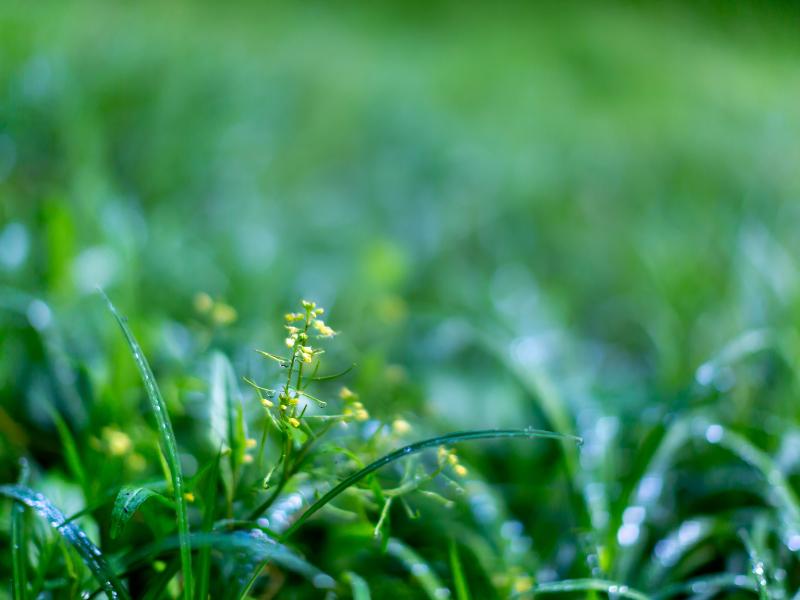
Identification: The lobed foliage of the marsh yellowcress is adorned by clusters of four-petal flowers. The plant typically grows to a height of 2 feet.
Effect: The marsh yellowcress is an annual that doesn’t live long, but it spreads via seeds and invades your local habitat during its short lifetime. Fortunately, this plant isn’t considered invasive, so you’ll have plenty of time to eliminate it before it takes over your yard.
Restraint: You can hand-pull individual plants if the infestation is negligible since the weed has shallow roots. You need only ensure you take out the entire root system. Use broad-spectrum broadleaf herbicides if the problem proves challenging.
Skeletonweed
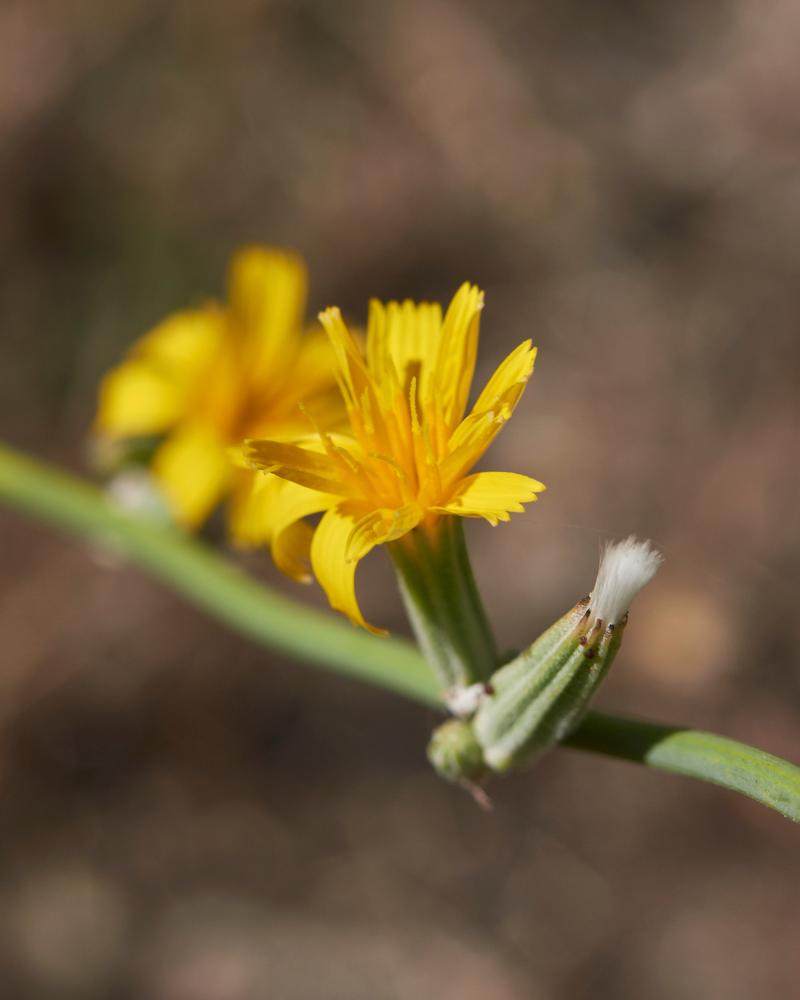
Identification: This weed gets its name from its long and almost leafless stems with strap-shaped flowers. The skeletonweed is thin but can get to a height of 4 feet and branches out extensively, so it’ll taint your lawn appearance.
Effect: The skeletonweed can multiply through several means; be it root shoots, root fragments, or seeds; the list is endless! In the Southwest, a mature plant is considered invasive and can bear up to 20,000 seeds.
Restraint: Thoroughly weed away any root fragments you notice and maintain a healthy lawn to subdue skeletonweed infestation properly. If the skeletonweed is already mature, mow it before it flowers to prevent it from seeding. Use weed killers with picloram, 2,4-D, etc., for larger infestations.
Purslane
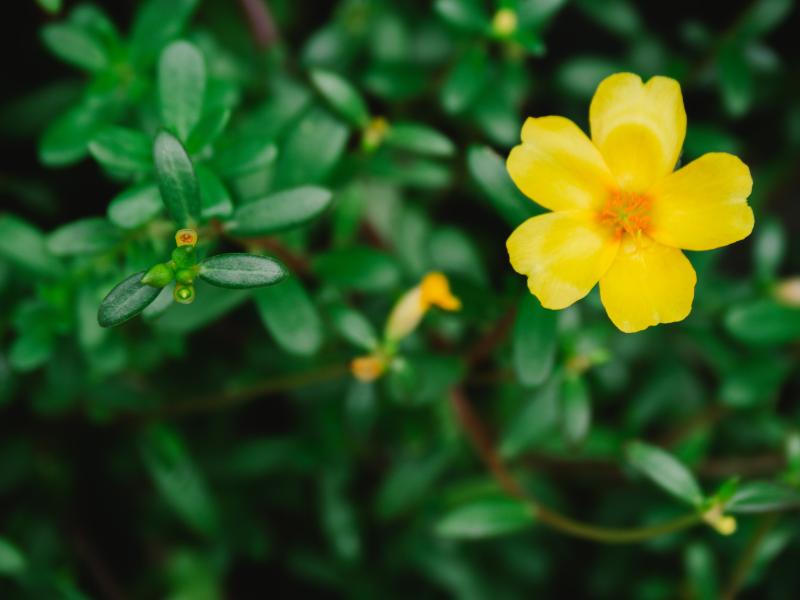
Identification: Purslane has small flower heads that have heart-shaped petals that protrude from the fleshy, huddled, oval leaves in the early morning. The plant only reaches a height of 3 inches but spreads about a foot and a half.
Effect: The scary bit about purslane is that one plant is capable of bearing 240,000 seeds that are functional for up to 40 years! Although the plant generally spreads through seeds, it can also spread through stem fragments. Purslane can damage your small ecosystem since it hinders the growth of native plants, leading to fewer pollinators and overall diversity.
Restraint: Preventing this weed from occurring in the first place is the best way to deal with it. Ensure you outsource your garden supplies from reputable dealers and use clean equipment to achieve this. If, by any chance, this weed becomes a problem, try covering it with dark plastic or mulching to prevent it from photosynthesizing. As mentioned earlier, herbicides aren’t really necessary when dealing with home lawns, but if you feel like you need to use them, opt for products containing MSMA, MCPP, dicamba, and 2,4-D.
Sow Thistle
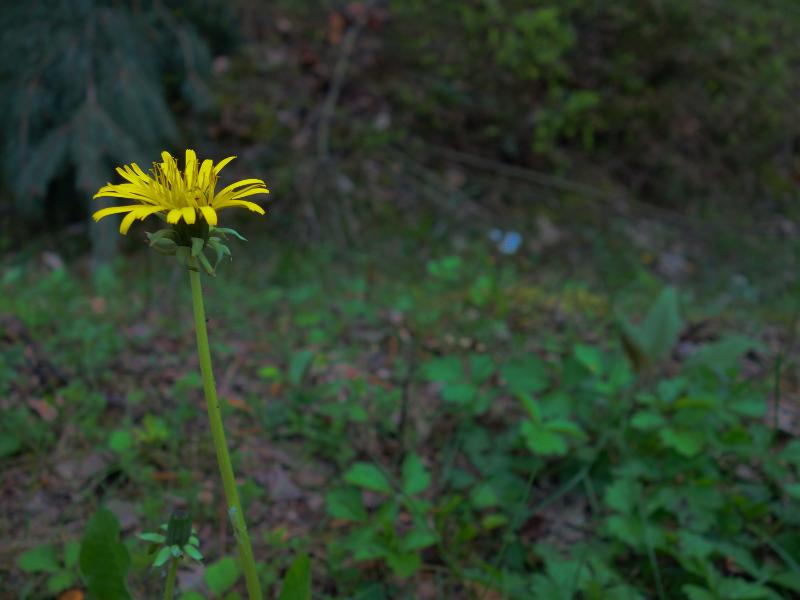
Identification: The flowers of sow thistle are similar to those of dandelions, but the plant is much taller and can reach heights of 4 – 6 feet. The foliage is also different, with the plant having larger, much more toothed leaves that are a bit prickly to the touch.
Effect: Sow thistle typically relies on the wind to spread its seeds; fortunately, these seeds don’t stay viable for an extended period. The bad news is that the plant is invasive and will suffocate your other plants. Alaska even banned it!
Restraint: If you have no issue with using herbicides, you can eliminate sow thistle using products containing paraquat and glyphosate. If you are more of an environmentally friendly type of person, you can remove the plant manually, even though it’ll consume a lot of your time and energy, and you must eradicate the roots.
Spanish Broom
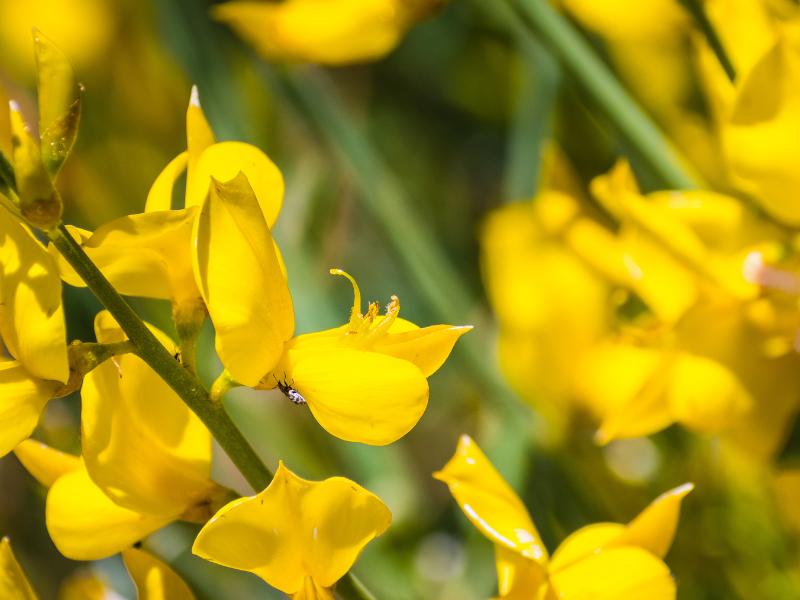
Identification: The bright yellow flowers and 6 – 10 feet of bushy growth of the Spanish broom give it a relatively pleasant-looking appeal. However, you’ll need to shape it if you plan on using it as part of your decor.
Effect: This plant is considered noxious, meaning it can cause gastrointestinal issues in animals and harm the environment. It spreads from seeds, and it’s an invasive species in North America. Given the chance, it can cause severe damage to your small ecosystem.
Restraint: You can pull and dig out the weeds if there are only a few of them. However, if the infestation is severe, it would be best to use weed killers containing glyphosate and triclopyr.
Wild Radish
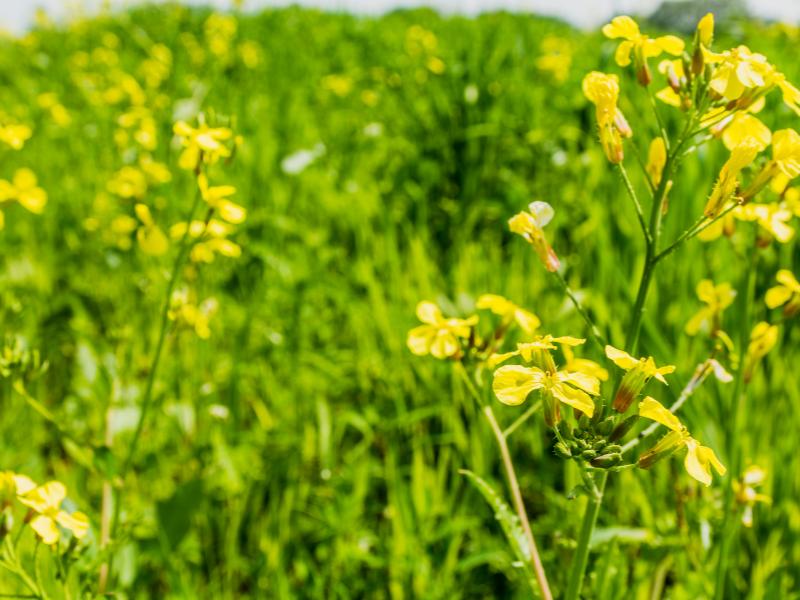
Identification: The wild radish’s petals come in groups of four and have a slightly oval shape. These petals are hardly connected to the flower head’s center. The plant’s top leaves are small and born on short stalks, and they resemble toothed footballs. The bottom leaves, on the other hand, are profoundly lobed and look like eggs.
Effect: Wild radish seeds can contaminate hay, wheat, etc., making their spread much more effortless. The plant is an invasive species that can outcompete and suppress native and beneficial plants. Wild radish is poisonous to horses, according to the ASPCA.
Restraint: Using herbicides is the best way to eliminate this plant since it saves you money and it’s effective. Go for products containing dicamba and 2,4-D, but pay close attention to your application, or you’ll end up ruining your lawn.
Wild Parsnip
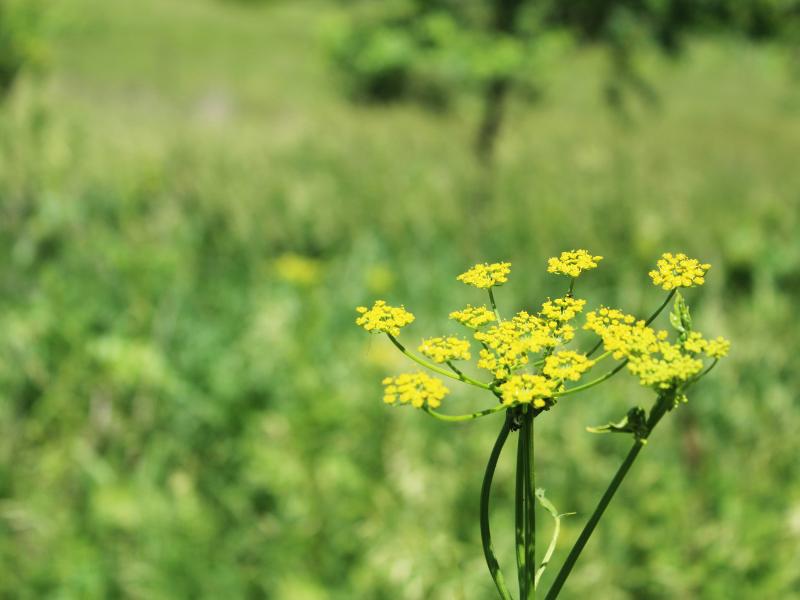
Identification: The Wild parsnip has a compound flower head that resembles an umbrella, and it contains many tiny flowers. The plant has soft and toothed, deep green leaves with an almost-like mitten shape. It can grow up to heights of 1.5 – 5 feet.
Effect: Although Wild parsnip isn’t that common on lawns, some stray seeds can still germinate and invade your lawn. The plant spreads its seeds rapidly and is aggressive, putting existing flora along the way in danger. The plant even has a chemical that can make your skin more susceptible to sunburn, so handle it with care.
Restraint: One way to control wild parsnip is to mow it down after it blooms but before it sets seed. However, if the seeds are already there, use a plastic bag to cover them, cut the flower heads, and get rid of them.
Wintercress
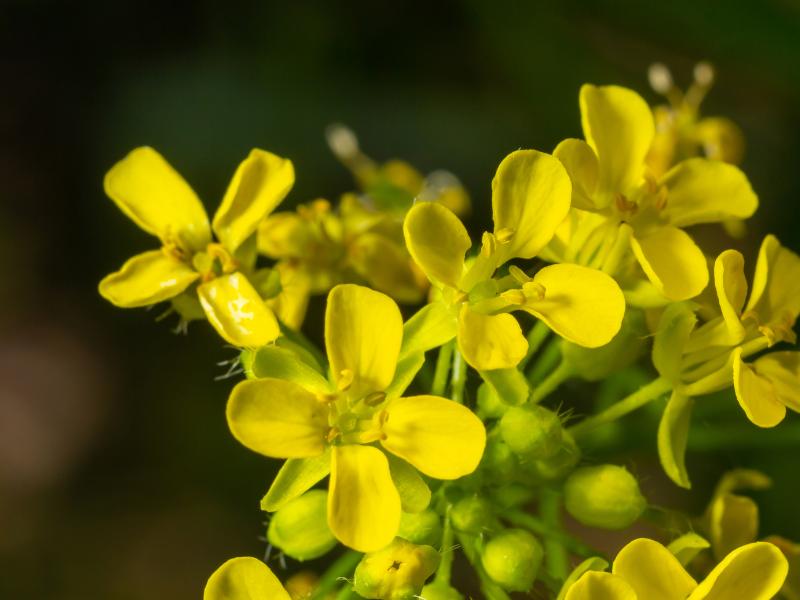
Identification: Wintercress is also called yellow rocket, and it has a compound flower consisting of numerous club-shaped flowers. The plant’s leaves are oval, but their ends have rounded lobes. Wintercress typically reaches heights of 12 – 25 inches.
Effect: This plant can self-seed, producing up to 10,000 seeds per plant. Wintercress can get aggressive and invasive, spreading all over your lawn if you fail to deal with it in its early stages. Furthermore, it’s toxic to horses.
Restraint: You can control this weed by digging up or mowing the entire plant, but you must do so before it flowers. Post-emergent, broadleaf herbicides containing 2,4-D are also another option you can explore.
Yellow Salsify
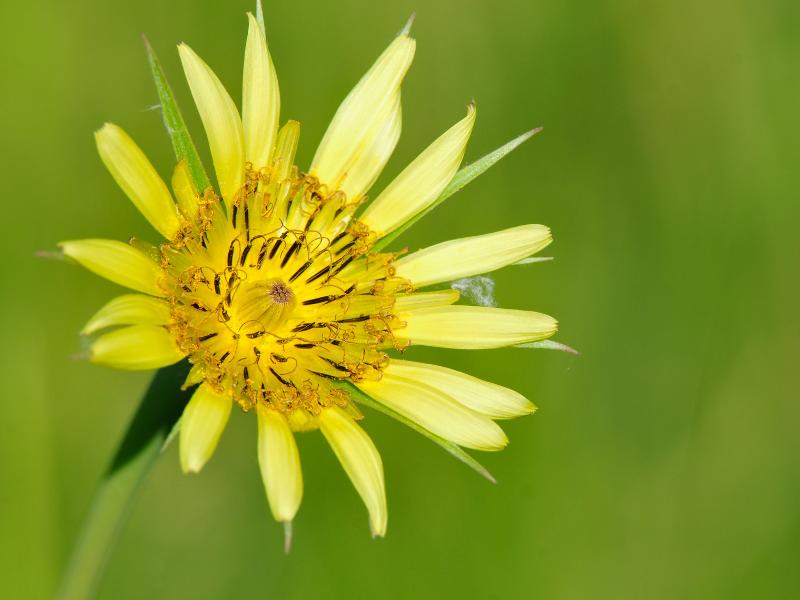
Identification: Another plant that looks like dandelions, but the leaves that are close to the flower give it a starry look rather than a rounded one. The yellow salsify’s leaves resemble grass, but they have a more triangular shape. The plant never exceeds a height of 3 feet.
Effect: Yellow salsify spreads by seeds, and one plant can bear up to 1,000 viable seeds. The seeds are light, making them easily transferable on your entire lawn or even further through the wind. Fortunately, this weed doesn’t impact the native ecosystem negatively, take up much space, or persist in any way.
Restraint: If you notice the plant appearing, you can pull it out, but you must remove all the roots. Mowing isn’t practical when dealing with yellow salsify, so you don’t need to change your normal mowing routine. If the infestation becomes a serious problem, you can use weed killers containing 2,4-D, dicamba, picloram, etc.
Yellow Nutsedge
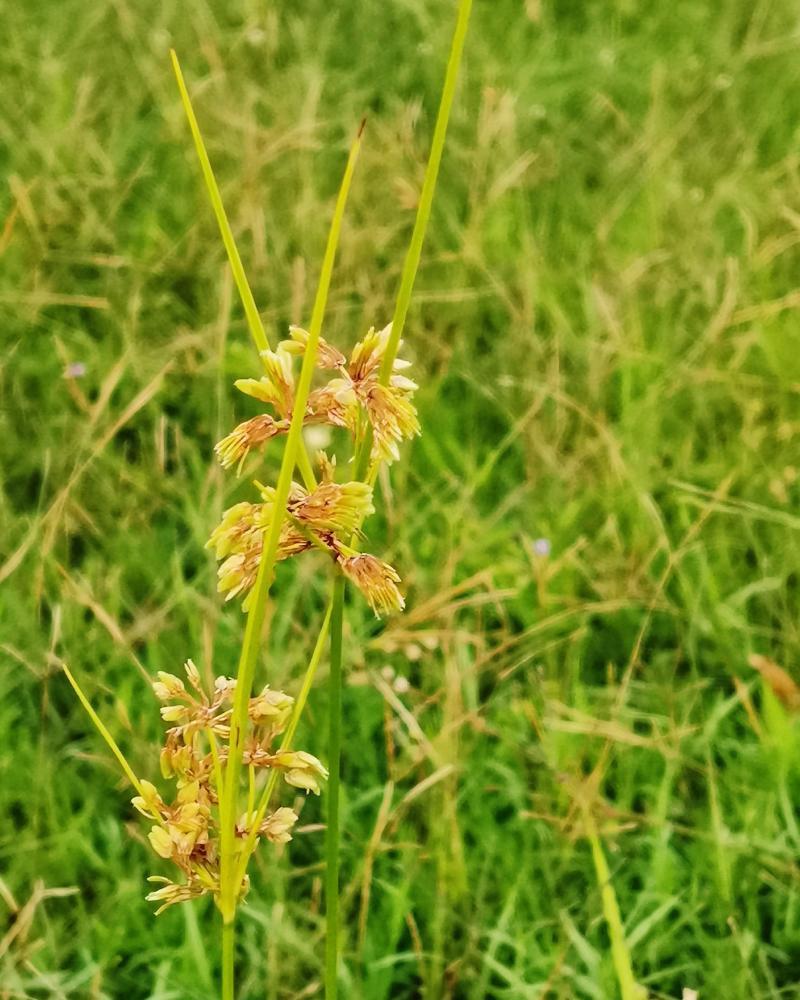
Identification: Yellow nutsedge is a weed that looks like grass, but has thicker blades that are coarser than the blades of most lawn grasses. The plant produces triangular-shaped flowering stalks that are adorned with thin, wheat-like blossoms. The yellow nutsedge can reach heights of 3 feet, so it’ll really stand out.
Effect: The yellow nutsedge grows from tubers, and you can transfer it together with the soil. The plant spreads through rhizomes, so it can easily take over your lawn. Fortunately, its seeds hardly germinate, but it’s still regarded as invasive.
Restraint: The yellow nutsedge can go undetected for a pretty long time before you notice it has spread all over your lawn. Digging and pulling the yellow nutsedge out at this point is pointless, so weed killers are the best option you have of eliminating this weed. Cool-weather grasses are best controlled by weed killers containing sulfentrazone and halosulfuron.
Yellow Hawkweed
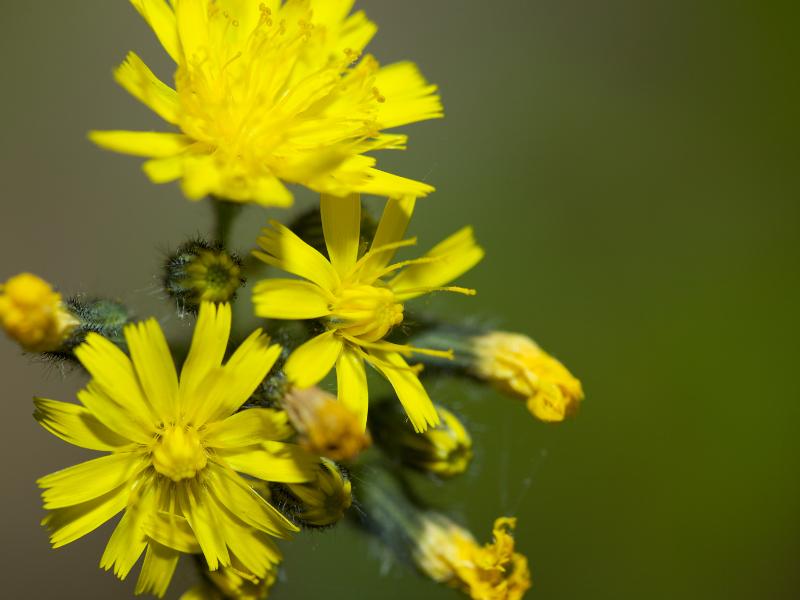
Identification: Yellow hawkweed is another plant that resembles dandelions. The plant’s stems branch towards the top and contain golden blossoms, but they are primarily without foliage. The height of the yellow hawkweed is the distinguishing feature, with the plant growing up to 3 feet tall.
Effect: The yellow hawkweed multiplies by seeds, rhizomes, and stolons, making it almost impossible to prevent its spread. This makes the yellow hawkweed challenging to control and somehow invasive, but the good news is that it’s not toxic to pets and humans.
Restraint: The most effective way to control yellow hawkweed is to remove it by hand in the spring before it blooms and spreads to your entire lawn. Use weed killers that have glyphosate if the infestation is already out of control. Remember, this product can also kill grass, so you’ll need to reseed it sometime afterward.
Yellow Lantana
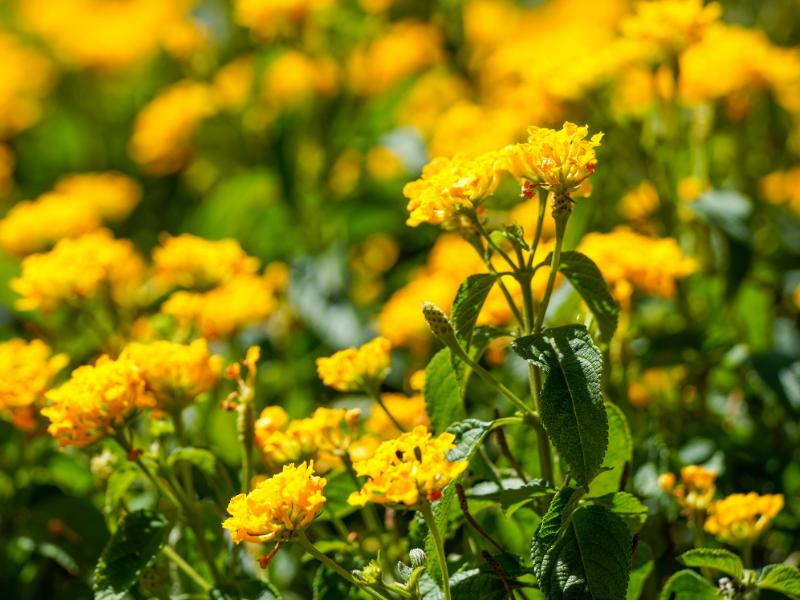
Identification: The yellow lantana has gorgeous hydrangea-like flower heads that give it a mesmerizing look, but it’s still considered a weed. The plant’s broad leaves have a rough texture and are slightly toothed, with an oval-like shape. The yellow lantana has a bushy appearance and can grow up to 6 ft tall and 10 ft wide.
Effect: This plant can self-seed, but since the available species are mostly ornamental, you can only use cuttings to multiply it. As a result, it poses a low risk of harm to your landscape and other flora in your garden.
Restraint: The yellow lantana isn’t invasive and won’t harm your small ecosystem, so there isn’t necessarily a reason to get rid of it. However, since the plant can take up large portions of land, it would be best to place a border between it and your lawn or move the plant about 10 feet away from your lawn.
Yellow Sorrel (Oxalis)
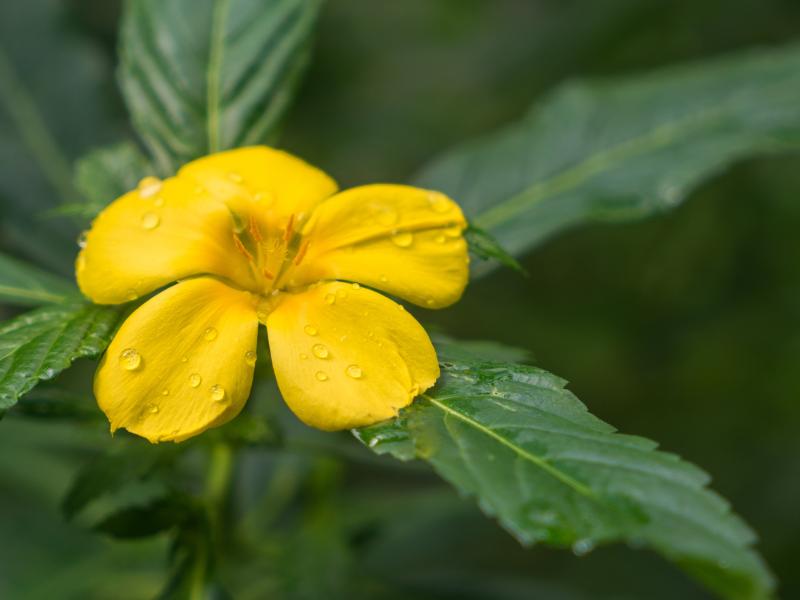
Identification: You’ll find the yellow sorrel on the list of weeds with blue flowers, but the plant will have sky-colored flowers. The plant has green shamrock leaves and inverted-heart flowers that won’t necessarily bother you because the plant only reaches heights of 3 – 8 inches.
Effect: This weed spreads through rhizomes and seeds, and can quickly spread all over your lawn and garden. However, the yellow oxalis isn’t considered invasive, so that’s some good news.
Restraint: One of the most effective ways of preventing yellow sorrel is keeping your lawn healthy and maintaining it; this will also suffocate the plant while it’s still young. Alternatively, if you see heart-shaped flowers in your grass, you can remove the plant by hand. Ensure you remove all the roots and do it before the plant flowers.
Yellow Toadflax
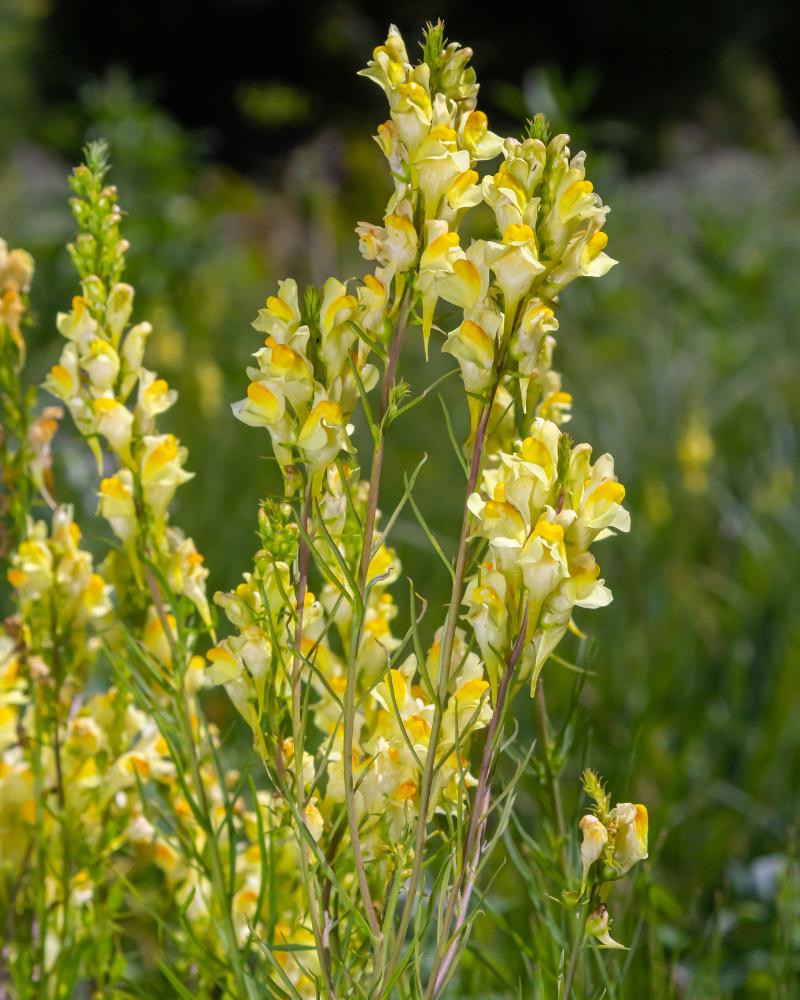
Identification: The yellow toadflax’s creamy-yellow flowers look like snapdragon flowers, but they are more like bottle brushes. The plant’s pointy, lanceolate, and silvery-green foliage resembles grass blades, but since they grow on stalks and come in pairs, you can quickly identify them. The yellow toadflax reaches a height of 1 – 3 feet.
Effect: Similar to the yellow oxalis, the yellow toadflax multiplies through seeds and rhizomes. The plant grows in patches, ruining the texture and form of your lawn. The yellow toadflax is poisonous in western states, including New Mexico, Colorado, etc., and has an invasive nature.
Restraint: Use products containing chlorsulfuron or picloram once you notice a couple of these plants flowering in your lawn. However, it would be best to combine diflufenzopyr and picloram to yield better results.
Final Remarks
We’ve covered an extensive list of weeds containing tiny yellow flowers that might invade your lawn and take over it.
To be fair, some weeds on the list are alluring, but they’ll look much better in a rock garden or a similar setting than in your all-green lawn or yard.
We hope the tips we’ve shared will help you identify various species and eradicate them.
See you next time, bye!

